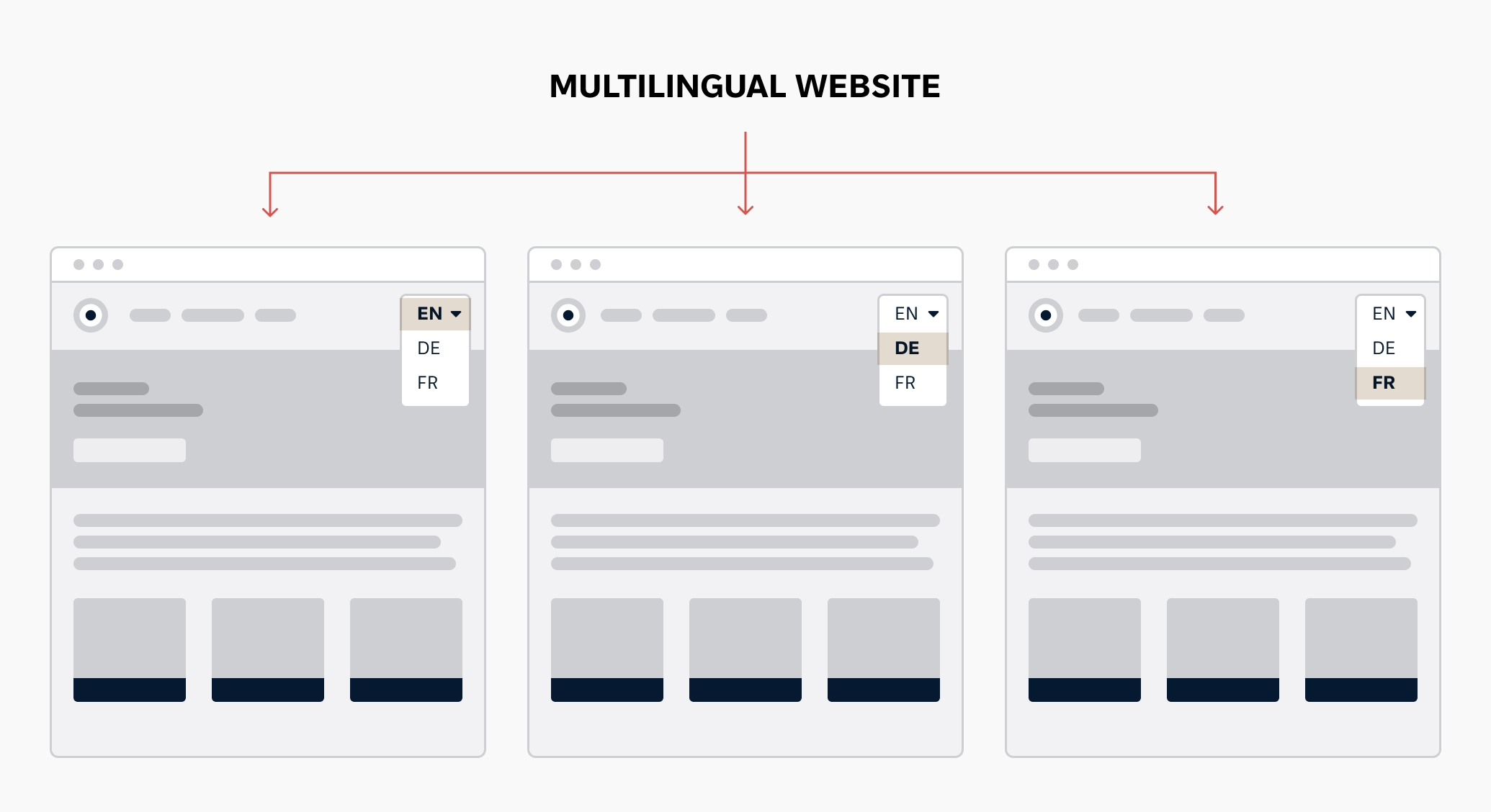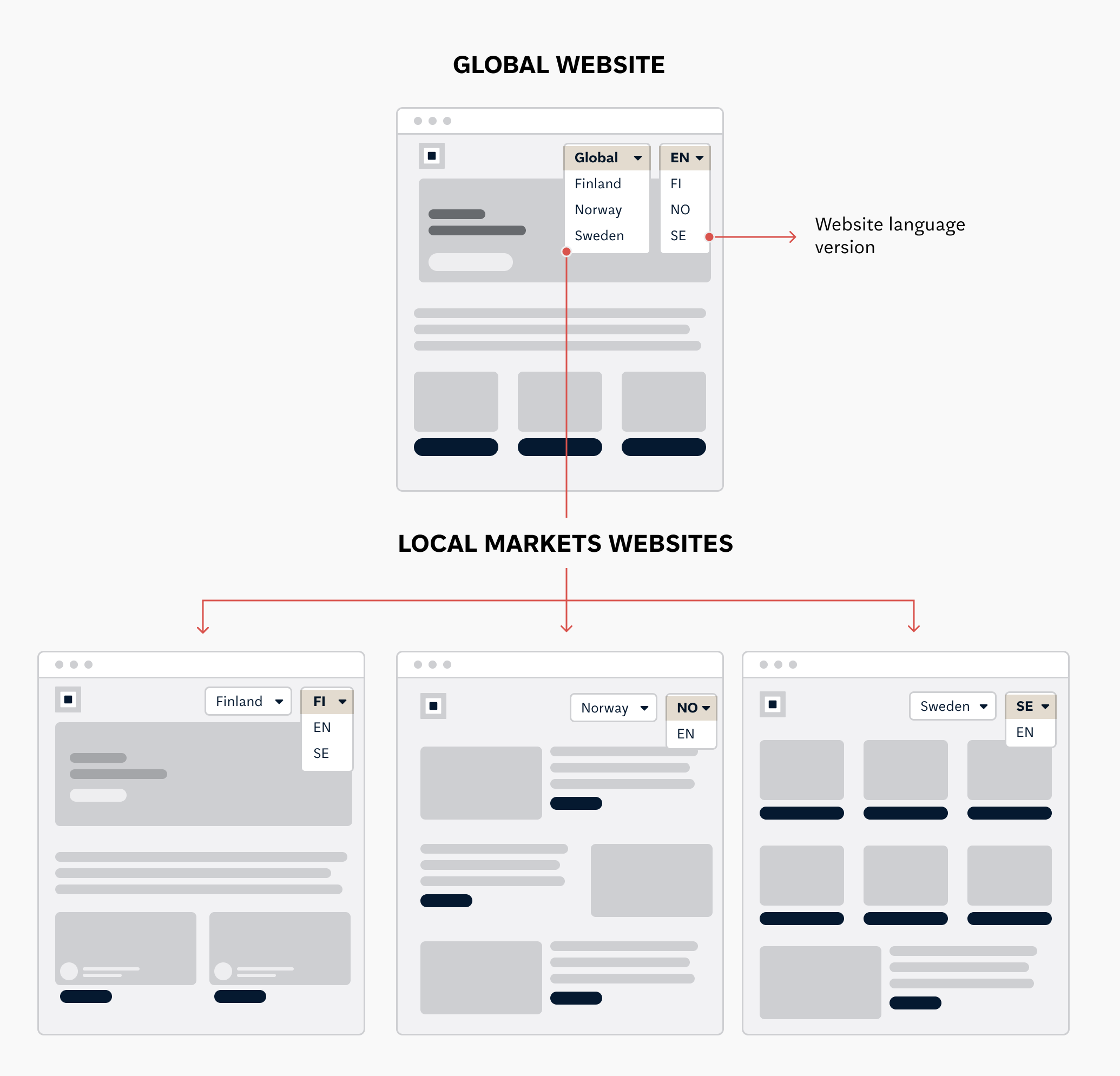Streamlining communication and marketing in an international organisation through a CMS
June 25, 2021 / 6 min read

International organisations with communication and marketing teams dispersed all over the world often struggle to balance empowering local content editors, marketers, communication specialists and keeping all the processes unified and aligned with global communication strategy. Cultural and language differences, as well as regional market specificity, make things even harder. This article describes an approach towards building communication and marketing-oriented websites for organisations operating internationally, with examples for both small, medium and large-scale companies.
For the sake of this post, put yourself in the shoes of a CMO in a large, international organisation. Your goal is to keep everything marketing-related effective, adjusted to local market needs, but also compliant with the company’s global strategy. Easier said than done, correct? We perfectly understand the complexity of this job. That’s why we decided to facilitate your work by breaking it down into prime factors. We invite you to take a look at our findings!
Marketing and communication in an international setup
When building communication and marketing processes and channels, primarily websites, companies operating internationally often face challenges that can be grouped into three categories:
- Structuring roles and responsibilities in the distributed team(s), so that the people participating in content creation understand their level of autonomy and the content management workflow.
- Designing information architecture suitable to the size and structure of the organisation to support both local offices and group-level communication, including proper domain structure (global .com domain vs. local country domains).
- Selecting a tech platform (CMS) that enables effective collaboration, content production and publishing in a multi-country and multi-language environment.
The solution for the three aforementioned challenges may differ based on the size, structure and specificity of the given enterprise. However, no matter where your starting point is, the proper solution is always a resultant of a thorough design process taking into account business, organisational and technical aspects alike.
THREE CHALLENGES, ONE GOAL
First off, we start with clarifying the actors involved in content production and publishing: their goals, responsibilities and autonomy. Large organisations with local marketing teams distributed in many countries typically struggle with finding the perfect balance between autonomy of the local offices and alignment to the overall business strategy.
In such cases, we advocate for designing a workflow and content approval process to keep content production flexible yet controlled.
Secondly, we analyse the size and structure of the organisation. We have to primarily take its offer and target audience into account to come up with adequate information architecture. And by information architecture, we mean chiefly the way content on the website is structured. This includes domain structure.
For smaller companies, it is often enough to maintain the .com website, whereas large companies may need a local version targeted towards local markets.
Lastly, we propose a comprehensive IT solution (a CMS or DXP in the case of the largest companies) that supports effective collaboration between departments and offices and seamless content production and publishing in a multi-country and multi-language environment.
In short, the CMS abbreviation stands for a content management system. Typically, it's an online software or application used to manage digital content creation through various channels and websites in a company.
WHAT DO YOU NEED TO KNOW ABOUT CMS/DXP PLATFORMS?
Today, there’s a long list of various CMS platforms, starting with open-source ones (like WordPress and Umbraco) and ending with enterprise-level solutions like Optimizely, Contentful and Progress Sitefinity.
These platforms are designed to serve as a base for your content marketing strategy. They allow you to:
- Create and manage new pieces of content
- Keep diverse communication channels in one place
- Supervise everything marketing-related from one intuitive dashboard
The most advanced and complex CMS platforms are frequently referred to as DXPs (digital experience platforms). If you are interested in their capabilities, we invite you to read our blog post about DXPs. Here, let’s focus on building and managing websites in international companies.
Major approaches to building international communication and websites
As we've already told you, it all depends especially on the size of your company. The more extensive your marketing team and the more offices you have, the more complex building and managing communication becomes.
1. Small companies (single brand, single website, multiple languages)
Smaller but still international companies typically maintain a single website with a unified structure across all markets. The information provided to visitors is often the same regardless of the market. However, the content may be translated into multiple language versions. The process of content management is centralised, and there is usually no need for complex approval processes.
In some situations, content for the specific market can be translated and localised to make it more relevant and appealing to the given target audience. This is how it usually looks like:
In most cases, there is just one website with different language versions. These language versions can have their own content (e.g., blog posts) and sometimes even structure (additional sections for specific markets). But it all happens within just one webpage.
A good example of a company working this way is IBO.org. It's a company that offers high-quality international education programmes to more than one million students in more than 146 countries. They have just one website with three language versions. Each version has its own localised content, but the general architecture remains the same.
2. Mid-sized companies (single brand, multiple websites, multiple languages)
Here, things start to get more complicated. Although the brand is the same worldwide, there is more than one website, and of course, many language versions. In such a setup, marketing specialists (or whole marketing teams) are dispersed across local offices to streamline communication with local customers.
Here’s how it usually looks like:
Indeed some elements are common. There is one major global content strategy, but there are also additional typically local pieces of content and messages. In many instances, these websites have a unified layout (it’s not mandatory, though), but they are evidently customised by and for local marketing teams to fit the local market. Articles and other similar pieces of content (news, press releases, messages) are also tailored to local needs.
A good example of this model in action is our agency. NoA Ignite offices are located in Poland, Norway, Sweden and Denmark. The agency has one main website and several other websites made specifically for local markets – just like ours: noaignite.co.uk. Each agency has its own website with a separate layout, structure and content.
And take a look at NRC Group. It's a Nordic infrastructure company developing and supplying products and services for sustainable transport solutions. NRC operates in Norway, Sweden and Finland. Each division has its own website. Furthermore, NRC Group established local marketing departments in each country, and their role is to create and distribute content specifically for the given market. And yes, possibly you've seen that these local web pages look pretty much alike. It can work this way. What's important is that each country has its own marketing team, which is a prerequisite in model 2.
3. House of brands (multiple brands, multiple websites, multiple languages)
That’s the most complex and extensive business model. Here, there is one large parent company and several smaller brands and companies, which are subject to it. This means what within one CMS, there are several brands to manage. All of them have their own websites, branding, and content. However, they can operate on similar components.
And it goes further! Large worldwide corporations operate based on a network of entities (branches) responsible for operation on a specific market. These companies handle all the local sales, HR, administration, marketing, PR and development projects and tasks. Naturally, each of these organisations is not a lone island. They answer to the mother company supervising them and setting the tone of global development and marketing.
All of that means that, in many instances, the architecture of each brand's website is unique and managed separately. Therefore, each brand requires a custom approach and development to ensure it can grow according to a specific strategy and vision. If such a house of brands is also active in the e-commerce world, each brand has its own personalised online store and offer. Frequently, people don't even know that some parent company supervises the brand they know.
This approach is common in the FMCG sector. Consider Unilever. It’s an FMCG giant running over 20 different brands in the US alone. Each of their brands has a section on Unilever’s main domain but also an entirely separate website, separate branding, separate social media profiles and marketing strategy. This is how it looks like from the website’s architectural point of view:
In all these three scenarios, a decent DXP platform can make a real difference. Thanks to DXPs, you can manage multiple websites and brands from one intuitive dashboard. This means that everything, from creating and accepting content to putting it online and implementing changes, can be facilitated and accelerated. As a result, your company saves a lot of time and can execute more marketing campaigns.
If you’d like to find out more about DXPs and discover how these platforms can help you in everyday work – just drop us a line! We will gladly help you find, adjust and manage the best IT solution that will enable you to achieve marketing-related goals.
Author

Dariusz Macina
Chief Executive Officer
Throughout over 15 years of career in IT he has been working in variety of technical, advisory and managerial roles delivering digital solutions to mid and large companies. A mix of technical and business consultancy experience allows him to advise clients on applying technology to achieve measurable business results. He worked for clients like Canal Digital, Electrolux, Nord Pool Spot, Norsk Hydro.
Related articles
![A well-crafted prompt doesn’t just work once. It works across teams, channels, and campaigns. It can be tweaked for new use cases and refined based on what performs best.]()
June 27, 2025 / 4 min read
Prompts are marketing assets: how to reuse, and scale them
Prompts aren’t throwaway lines. They’re repeatable, scalable assets that can streamline your marketing your team’s output. Learn how to build a prompt library that delivers.
![Woman using a wheelchair in the office settings]()
June 17, 2025 / 5 min read
What is accessibility and why it matters?
Accessibility ensures everyone — including those with disabilities or limitations — can read, navigate, and engage with your content equally.





